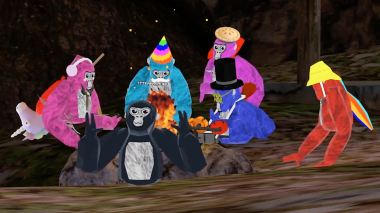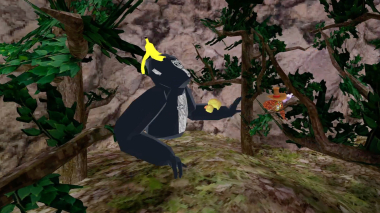
Gorilla Tag Review
The moment I strapped on my VR headset and entered the world of Gorilla Tag, I was pulled into an energetic and quirky universe that defied every expectation I had of virtual reality games. As someone who has tried many VR experiences, this game immediately captured my attention with its unusual take on locomotion and exploration. I found myself both amused and challenged as I discovered its unique physics, gameplay mechanics, and vibrant community. Every jump, climb, and swing felt incredibly immersive, and the joy in motion was something I had never experienced before.
Immersive Movement Mechanics
The standout aspect of Gorilla Tag, for me, is its intuitive yet challenging movement system. Maneuvering my gorilla avatar was all about using my arms to propel myself forward, climb trees, and leap between platforms. The game’s design forces you to rely on physical motion, so each action required a mix of careful planning and spontaneity. I particularly enjoyed the way the game simulated momentum, making me feel like every swing or jump was a calculated move in a real jungle. The lack of conventional controls invited me to exercise both my mind and body in synchrony.
Engaging Gameplay Dynamics
Gameplay in Gorilla Tag is an intricate dance of agility and strategy. I was both captivated by the chase-based modes and the exploration elements that the game offers. Every session felt like a test of my ability to adapt to quick changes. Whether I was evading another player during a chase, or using my surroundings to scale new heights, it was a constant battle against inertia. The pure joy of running and leaping through a virtual forest evoked a kind of physical and mental engagement that many traditional games simply cannot convey. I spent hours perfecting my techniques, honing my skills to navigate complex terrains that relied solely on natural motion physics.
Artistic Style and Visuals
Visually, Gorilla Tag presents a refreshing blend of simplicity and vibrant creativity. The minimalist graphics do not compromise the experience; rather, they add a unique charm to the overall presentation. I found that the low-poly aesthetic, paired with bright and dynamic color schemes, communicated a sense of fun and freedom. Although the visuals are not hyper-realistic, the endearing design of the gorillas and their smooth animations kept me thoroughly engaged. This artistic choice, highlighting form over intricate detail, reinforced the game’s emphasis on movement and interaction rather than on hyper-realistic simulation.
Physicality and VR Movement
As a VR enthusiast, I value experiences that make me feel physically present within the game world. Gorilla Tag excels in this regard by encouraging players to move their actual bodies to control their in-game avatars. I loved how every swing of my arms translated into a burst of acceleration, imitating the strength and grace of a real ape. The physicality of the actions felt incredibly rewarding, creating an exhilarating sense of presence in a world where movement is your main tool for exploration. This physical interaction not only made the gameplay exciting but also provided a fun form of exercise.
Interactive Environment and Obstacles
The environment of Gorilla Tag is anything but static. I was intrigued by how the game incorporated a natural setting into every aspect of gameplay. Trees, platforms, and even the ground became integral components of my overall strategy. I often found myself assessing each branch and ledge as potential aids or hindrances during fast-paced chases. The ever-changing environment demanded constant awareness and quick reflexes. I engaged in numerous encounters with environmental obstacles that required precise movement and split-second decision-making. Every miscalculation was a learning opportunity, and mastering these elements felt both thrilling and gratifying.
Social Interaction and Multiplayer Fun
One of the most compelling elements I experienced in Gorilla Tag was the social dynamic among players. The game creates a collaborative and sometimes competitive community where every session felt personal. I savored every exchange with fellow players, each adding their own distinctive flair and vitality to the game. There is a palpable sense of camaraderie in Gorilla Tag; laughter and shouts echo in the virtual canopy as players share in the excitement of every chase and leap. The game’s multiplayer mode is more than just a competition—it’s an interactive playground where encouragement, friendly taunts, and moments of spontaneous teamwork create unforgettable memories.
Experimental Physics and Intuitive Control
As I delved into the mechanics of movement, I was continuously amazed by how Gorilla Tag uses experimental physics as its backbone. The control scheme, while at first seeming unconventional, gradually revealed an intricate balance between momentum and gravity. I spent much time learning how precise arm movements affected my agility, and I eventually found this experimental approach to be both refreshing and enlightening. It opened up a new perspective on how motion works in a virtual environment. Every movement felt authentic because the virtual physics were consistent and rewarding, making each session an immersive experiment in digital locomotion.
Challenge and Skill Mastery
The game offers a steep learning curve that pushed me to refine my skills continually. Initially, I struggled with the nuances of momentum and balance, but every session served as a practice ground that honed not just my in-game performance but also my coordination and spatial awareness. With every misstep came a valuable lesson, and I began to see noticeable improvements in my technique. The challenge is balanced in a way that rewards persistence and dedication; the more I played, the more intuitive the movement became. This slow but rewarding progression transformed each play session into a deeply satisfying personal achievement.
Customizability and Personal Style
Another aspect that truly resonated with me was the game’s openness to personal expression. Gorilla Tag allows players to personalize their experience, from avatar appearance to movement styles. I enjoyed experimenting with different in-game accessories and adapting my play style to reflect my personality. The flexibility in customization contributed to a sense of ownership over my virtual presence. I felt as though I could craft my own identity within this vibrant community of gorillas. The freedom I had allowed me to dive headfirst into the experience, inspiring me to explore innovative approaches and techniques to elevate my performance.
Sound Design and Auditory Experience
The auditory aspect of Gorilla Tag played a significant role in deepening my immersion. The sound effects, although simple, were meticulously crafted to convey the nuances of every action. From the rustling of leaves during a high-speed chase to the subtle creaks of branches under the weight of a leap, each sound was a vital piece of the immersive auditory puzzle. The dynamic audio cues provided me with crucial feedback on my movement, alerting me to potential hazards or opportunities. I found that the sound design not only enriched the environment but also synchronized perfectly with the physical movements, adding yet another layer of realism to the game.
Evolution and Community Impact
Over time, the community around Gorilla Tag has evolved into a vibrant and enthusiastic group that continually pushes the boundaries of what the game can be. I was lucky enough to participate in community events and challenges that brought together players from all over. These experiences were more than just game sessions—they were opportunities for collaboration, creativity, and shared joy. I observed how community-driven innovations often led to new gameplay modes and inventive strategies that even the original developers hadn’t anticipated. Being part of this evolving landscape was incredibly inspiring, as it showcased the endless possibilities available when creativity meets virtual reality.
Exploration and Creative Discovery
The exploratory aspect of Gorilla Tag allowed me to venture into areas of the game that were both intentionally designed and serendipitously discovered. I was constantly surprised by secret routes, challenging climbs, and hidden pockets of the virtual jungle that offered a refreshing break from the usual chase dynamics. Every time I discovered a new path or clever shortcut, the sense of pride and wonder was palpable. In moments of relaxed exploration, I felt as if I were retracing the ancient forests of a long-forgotten world, where every tree and rock had a story to tell. The creative discovery embodied in this game was a constant reminder of how open-ended the design truly is, inviting every player to leave their own mark on the expansive environment.
Physical and Mental Engagement
Beyond the obvious physical engagement, playing Gorilla Tag also provided a stimulating mental workout. Each session was a blend of mental strategy and physical dexterity that required deep concentration. I became adept at reading the environment, anticipating the movements of other players, and planning my jumps with precision. The interplay between physical action and mental challenge created a rhythm that was both exhilarating and meditative. I appreciated the way the game forced me to think on my feet while also engaging my muscles, blending exercise with cognitive challenge in a novel way. This rare combination of mental and physical stimulation made every play session an adventure in personal growth, pushing my limits in both realms.
Unique Competitive Spirit and Friendly Rivalry
The competitive elements of the game infused a unique energy into every match. I found myself constantly pushing to outmaneuver my fellow players, transforming every round into a spirited contest of agility and wit. The friendly rivalry was both contagious and admirable; every encounter was a reminder of the collective passion within the player base. I remember moments where the competitive spirit led to unexpected alliances as we worked together to overcome challenging obstacles. This dynamic environment, where every competition was filled with respect and humor, took the concept of competitive play to a level that felt both challenging and immensely enjoyable. The ever-present competitive spirit inspired me to keep refining my movements and was a major factor in my long-lasting commitment to the game.
Adaptive Learning Curve and Personal Triumphs
My journey in Gorilla Tag is a narrative of constant adaptation and personal triumph. At the onset, I found the controls perplexing, and the physics demanding. However, with time and repeated attempts, I began to notice improvements in not only my game performance but also in the way I perceived physical motion in a virtual space. Every small accomplishment, such as managing a particularly tricky maneuver or successfully navigating a challenging chase scenario, resonated deeply with me. These personal triumphs, though seemingly minor, accumulated over time and increased my confidence in the game. The gradual learning curve became a source of enjoyment; experiencing incremental success made every session more engaging and fulfilling. This adaptive progression was a crucial aspect that kept me returning to the game, eager to master its intricacies further.



